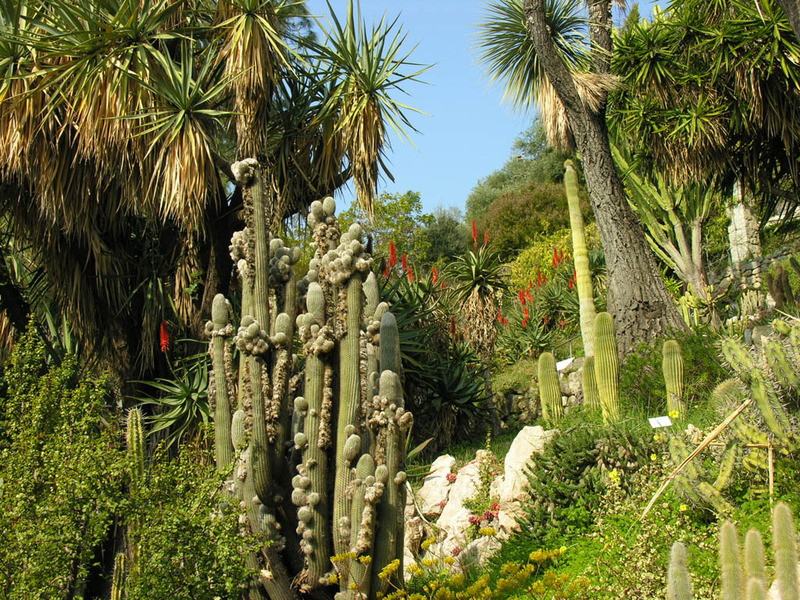Thomas, Daniel and the Making of a Garden
Daniel Hanbury was an enthusiastic traveller, taking every opportunity to further his research on materia medica. When in March 1867, his brother Thomas, who had worked as a merchant in Shanghai, purchased the ruined Palazzo Orengo in La Mortola, with its neglected grounds and olive groves, Daniel immediately saw the plot’s potential with its temperate climate and sheltered position.
Once purchased, work began immediately to restore the Palazzo and to create a botanical garden. With his extensive knowledge of plants, Daniel’s influence on the early garden was considerable. Through his numerous contacts, he was able to obtain plant species from around the world, including those which were considered of particular use to pharmacy then, examples being Iris florentina, Casimiroa edulis, and Euphorbia resinifera.
Curator Alwin Berger’s notes in Hortus Mortolensis (1912) show the extent of Daniel’s involvement in those early days: He brought Aloe arborescens and var. frutescens to the gardens from Kew, and he introduced other Aloe species, including A. ferox.

Succulents in the Hanbury Botanical Gardens. Reproduced with kind permission of Giardini Botanici Hanbury, Università di Genova. https://giardinihanbury.com
The seeds of Argania sideroxylon, ‘the Argan tree of Morocco’ were provided by Daniel. He planted Cereus peruvianus, C. nycticalus, C. tortuosus, and C. triangularis, supplying many other plants in the genus. Daniel started the collection of Opuntias at La Mortola and, together with Thomas, planted Opuntia ficus-indica ‘in a great many places in the garden’.
There are numerous examples of Daniel’s contributions, but the most interesting entry relates to Styrax officinalis. Daniel planted ‘a dozen young trees […] near the house on November 14th, 1868’. He had attempted to extract the resin, known for its medicinal properties, on different occasions throughout his travels, finally achieving his aim, Berger writes, at La Mortola in December, 1874.
Daniel’s involvement continued until his untimely death in 1875.
A pharmaceutical chemist’s holiday
So much has been written about the Hanbury gardens at La Mortola. There are accounts of the changes and improvements undertaken by Ludwig Winter, a trained gardener and landscaper employed by Thomas, and how Thomas’ son, Cecil, developed the gardens, alongside his wife, Dorothy, adding avenues of cypress, rare plants and additional species from around the world. The Hanbury Gardens were purchased by the Italian government in 1960, but their future was finally secured when Genoa University took over management in the mid-1980s.
One notable article appeared in The Chemist and Druggist in 1906, in which pharmacist William Maskew described his visit to the gardens whilst holidaying on the Riviera. ‘All the garden paths lead down towards the sea’, he wrote, ‘and I did not find a square yard of garden devoid of interest to the pharmacist’. Of particular interest were the various species of agaves and aloes, cacti specimens and the Bottle-Brush tree from Australia.
There were yuccas, Camellia japonica and Pinus pinea. Indigenous plants had been allowed to grow wild in one area and here alone there were 450 plant species.
‘Under the front terrace of the house is a museum of seeds’, Maskew explained, ‘stored in glass-stoppered bottles carefully arranged and catalogued’. Although not for sale, the seeds could be exchanged for ‘varieties of interest’ and in the catalogue were the names of ‘several British pharmacists who had availed themselves of this privilege’.
‘A visit to La Mortola’, he concluded, ‘should not be missed by any pharmacist, naturalist or antiquary who may find himself anywhere between Cannes and San Remo’.
You might decide to take William Maskew’s advice and visit the Hanbury Botanical Gardens. And, if you do, just imagine the Hanbury brothers discussing their plans, and feel work pressures recede as you stand on the hillside, gazing far out to sea.